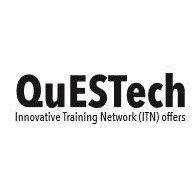QuESTech - QUantum Electronics Science and TECHnology training

Objective
Quantum Electronics provides a challenging and innovative multidisciplinary framework for training young researchers with excellent prospects for a career either in the industry or in academia. In this promising area, the “Quantum Electronics Science and Technology training” project, with acronym QuESTech, will create a European network of experts providing state-of-the-art training for young researchers in the general field of experimental, applied and theoretical Quantum Electronics.
The overarching science and technology goal of our research programme is to build, study, and qualify quantum electronic devices. QuESTech will train 15 Early Stage Researchers (ESR) through research in the sub-fields of spintronics, single-electronics, quantum dots, and quantum thermodynamics. The individual research projects will include technological developments in terms of nanomaterials growth, nano-structuring, near-field microscopies, transport measurement under extreme conditions and theoretical calculations. Several QuESTch results are already identified to be of commercial interest for the emerging Quantum Electronics industry.
Systematic secondments will be organised, including for every researcher a secondment of two months to a private sector partner. QuESTech will organise three sessions of the European School On Nanosciences and Nanotechnologies (ESONN) devoted to Quantum Nano-Electronics, combining both theoretical and practical training, and open them to young researchers outside the consortium. By 2021, we aim to have prepared a new generation of young researchers able to address the emergence of “Beyond C-MOS“ nano-electronics.
NanoGUNE's projects within QuESTech
Spin-to-charge conversion in strong spin-orbit coupling systems.
An ultimate goal of spintronics is to be able to create and manipulate spin currents without the need of any ferromagnetic materials and in this context the spin Hall Effect (SHE), which transforms an electrical current into a spin current, has been the main mechanism to be studied. Novel spin-orbit coupling related effects, which are potentially more efficient than the SHE, have been recently discovered. The objective of this project is to explore, understand, and improve some of these effects using the spin absorption technique.
An ESR will be hired to carry out this research project under the supervision of the Ikerbasque Research Professor Felix Casanova, senior scientist at the Nanodevices research group, at nanoGUNE. The ESR will study interfacial systems with surface states where the Rashba spin splitting is large. In these systems, the Rashba-Edelstein effect (REE) is expected to be larger than the bulk counterpart, the SHE. Interfaces with large REE, either metal/metal and metal/insulator bilayers, namely Ta/Cu, Ta/Ag, Cu/Bi2O3 and Ag/Bi2O3, will be explored. In a second stage of the project, (s)he will move on to 3D topological insulators. These materials conduct only at the surface and present an extremely strong spin-orbit coupling causing a spin-momentum locking. Accordingly, we will explore prototypical TI materials such as Bi2Se3, Bi2Te3 and their alloys with Sb, which should provide a novel exciting way of playing with the spin-charge inter-conversion. This will be developed in close connection to the work developed by another ESR at LEEDS (UK) in the 2D analogue systems.
Advanced hybrid organic spintronic devices with small spin-orbit coupling
The objective of this project is to explore hybrid organic spintronic devices in which to perform spin transport and manipulation beyond simple spin valves. An ESR will be hired to carry out this research project under the supervision of the Ikerbasque Research Professor Luis E. Hueso, Group Leader of the Nanodevices research group, at nanoGUNE.
In the first place, with the aim of exploring the spin transport mechanisms in organic materials with small spin-orbit coupling, the ESR will fabricate double organic spin hot-electron transistors in which the spin current can be manipulated by an external out-of-plane magnetic field. For the proof-of-principle devices, C60 fullerene will be used, as well as metal-organic molecules such as CuPc and Alq3. The observation of the effect of the spin precession will be the first in this discipline.
The ESR will then merge the spin transport with other organic functionalities, such as photoconductivity or the photoelectric effect. In particular, the student will explore the concept of self-powered hybrid organic spin valves-photovoltaic cells. (S)he will fabricate multi-layered organic devices in which exciton-to-carrier separation occurs at the organic homo-interface. The charge carrier will be utilised for powering the device autonomously, but also for performing spin manipulation. Here we will focus again on the molecules named above (making use of the p- and n-type conductivities for creating natural energy barriers) together with some polymers such as P3HT and N2200.
-
Centre National de la Recherche Scientifique CNRS, France (Coordinator)
-
CIC nanoGUNE, Spain
-
Raith Gmbh, Germany
-
University of Konstanz, Germany
-
ETH Zürich, Switzerland
-
Graphenea SA, Spain
-
Aalto University, Finland
